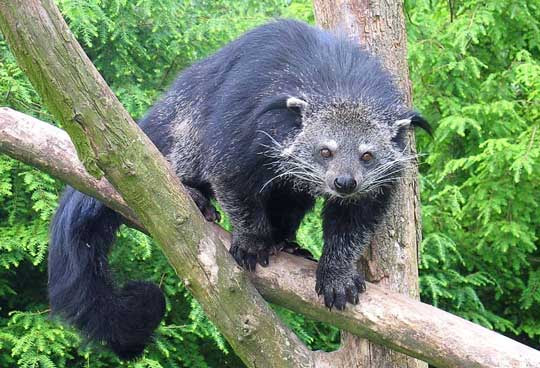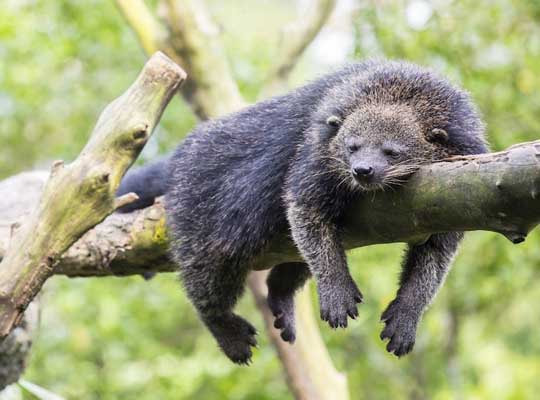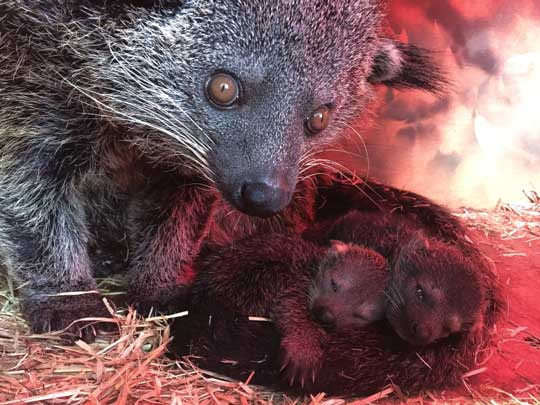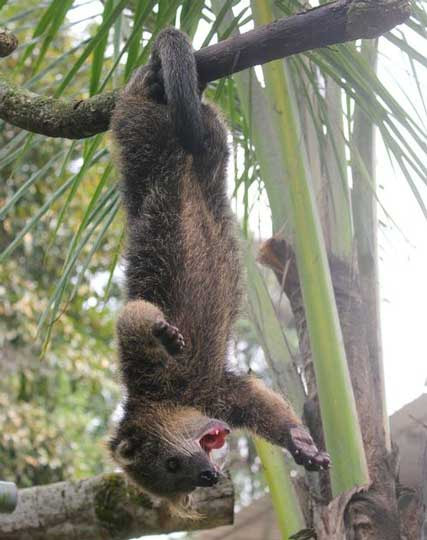|
Thanks to Tiffany and her son, Royce, for suggesting the Binturong. It's often called a bearcat, but it is neither a bear nor a cat. It smells like buttered popcorn, but I'm pretty sure it doesn't taste like popcorn. The binturong is a viverrid. What is a viverrid, you ask? Let's find out more. What the heck is a Binturong? The binturong is a mammal that lives in South and Southeast Asia. As I said above, although it is called a bearcat, it is actually in the family Viverridae (the viverrids), which is an ancient group of mammals found only in the eastern hemisphere. The family also includes civets and genets. Binturongs have shaggy, black hair, stiff white whiskers, and a monkey-like prehensile tail. So perhaps instead of calling it a bearcat, people should call it a bearcatmonkey (although it's really none of these). Amazing facts about Binturongs Although binturongs are in the order Carnivora, they eat as much (or more) fruit as they eat other animals. When they do hunt, they sneak around in the rainforest treetops like a cat and catch insects, birds, and rodents. They usually hunt at night, but they often eat fruit during the day, sometimes lounging around on branches as they handle the fruit with their agile hands. Binturongs can also swim and dive well, and on hot days they can even be seen catching fish as they cool down in the water. Binturongs are one of only two carnivore mammals that have a prehensile tale (the other is the kinkajou, which is unrelated and lives in Central and South America). They can use this tail as a fifth hand, to help them climb through the trees and hang on to branches. Binturongs are remarkably docile toward humans, and this has resulted in them being captured from the wild in large numbers, to be sold around the world as pets. This, along with destruction of vast areas of their forest habitat, has caused a significant decrease in the number of wild binturongs in Asia. They are also captured for zoos, and they are hunted for food. Unfortunately, today they are rarely seen in the wild. Okay, what's up with this buttered popcorn smell? It's true, and here's why: In the wild, binturongs are solitary animals—they rarely come face-to-face with each other. And that's the way they like it. To warn others away from their territory, they frequently urinate on the trees. The resulting smell is a signal to other binturongs, "Hey, I live here. Go away!" Oddly enough, they also use this smell during mating season, in which case the meaning changes to, "Hey, I live here. Want to stick around and make babies?" But I still haven't explained the popcorn smell. Scientists have identified 29 chemical compounds in binturong urine. The one compound found in every sample was 2-acetyl-1-pyrroline (let's just call it 2-AP). Remarkably, 2-AP is the exact same chemical that gives cooked popcorn its wonderful scent. But this creates more questions than answers! The 2-AP in popcorn is only produced when the popcorn is heated up and popped. The high temperature is necessary to get that smell. Binturongs are awesome, but they certainly can't produce such high temperatures in their bodies. So, we don't know for sure how they do it, but scientists suggest that the 2-AP might be produced when the binturong urine comes into contact with specific bacteria that live on the animals' skin or fur. Since males have more 2-AP in their urine than females, then it seems logical that leaving their scent on the branches not only tells other binturongs that a binturong is nearby, it even tells them if the nearby binturong is a male or female (precise communication is important, don't you think?). Let's talk about binturong babies for a moment. First, binturongs are one of the few mammal species capable of embryonic diapause. The means the female, once her eggs have been fertilized, can delay the eggs' implantation until environmental conditions are just right. Okay, in my opinion that qualifies as a superpower. The females can mate whenever they find a male, but then they can delay birth until they are ready. Typically, a female will give birth to only two babies, but sometimes there are as many as six. Check out this video of binturong babies. Binturong babies smell like popcorn as much (or more) than the adults. But... the babies also have their own superpower. During the first few months, when the young are most vulnerable, the babies have the ability to squirt out a foul-smelling liquid (like a skunk). As they grow older they become better able to protect themselves, and they soon lose this stinky superpower. Binturongs have an interesting relationship with strangler fig trees. Not surprisingly, Binturongs eat the figs from these trees and then poop them out somewhere. But as it turns out, a strangler fig seed cannot germinate on its own. It has to have the binturong's help. The binturong is one of only two known animals that have the correct digestive enzymes that can break down the tough outer covering of the fig's seeds. So this makes the binturong kind of important to the strangler fig trees. One last tidbit. Ever wonder what a binturong would look like in a formal portrait? Of course you have. Well, ZooPortraits is a fun organization that creates and uses "ironic caricatures" to teach about wildlife and to raise money for conservation. For your viewing pleasure, below is a binturong in a very formal setting (not exactly its natural habitat). So, the binturong deserves a place in the D.A.H.O.F. (Dope Animal Hall of Fame). FUN FACT: The word dope originated in the 1840s, and it referred to a thick liquid (such as a lubricant) used to prepare a surface. In the 1880s, the word began to be used to refer to any illicit drug. Then in about 1905, the word began to refer to news or information (What's the latest dope on the election?). And then much more recently, it became a slang word for cool (Yo, that new shirt is dope!). So, dope is another way to say awesome! Photo Credits:
Binturong #1 - Wikipedia Binturong lounging on limb - Wild Republic Binturong with babies - ZooBorns Baby binturong hanging in tree - ZooBorns Binturong formal portrait - ZooPortraits
0 Comments
Leave a Reply. |
Stan's Cogitations
Everyone needs a creative outlet. That's why I write. Archives
April 2024
|






 RSS Feed
RSS Feed